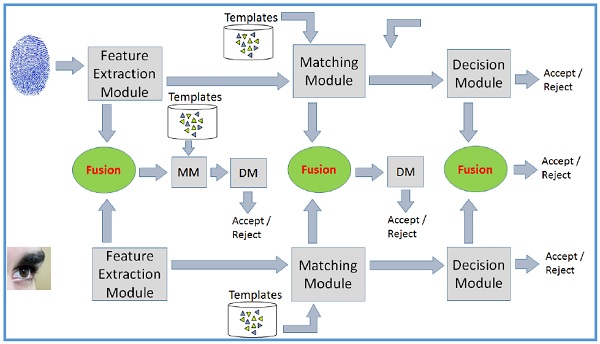
- Biometrics Tutorial
- Biometrics Home
- Biometrics Overview
- Biometric Modalities
- Physiological Modalities
- Behavioral Modalities
- Voice Recognition
- Multimodal Biometric Systems
- Biometric Modality Selection
- Biometric System Performance
- Pattern Recognition & Biometrics
- Signal Processing & Biometrics
- Biometrics & Image Processing
- Biometric System Security
- Biometrics Useful Resources
- Biometrics - Quick Guide
- Biometrics - Useful Resources
- Biometrics - Discussion
Multimodal Biometric Systems
All the biometric systems we discussed till now were unimodal, which take single source of information for authentication. As the name depicts, multimodal biometric systems work on accepting information from two or more biometric inputs.
A multimodal biometric system increases the scope and variety of input information the system takes from the users for authentication.
Why Multimodal Biometrics is Required?
The unimodal systems have to deal with various challenges such as lack of secrecy, non-universality of samples, extent of user’s comfort and freedom while dealing with the system, spoofing attacks on stored data, etc.
Some of these challenges can be addressed by employing a multimodal biometric system.
There are several more reasons for its requirement, such as −
Availability of multiple traits makes the multimodal system more reliable.
A multimodal biometric system increases security and secrecy of user data.
A multimodal biometric system conducts fusion strategies to combine decisions from each subsystem and then comes up with a conclusion. This makes a multimodal system more accurate.
If any of the identifiers fail to work for known or unknown reasons, the system still can provide security by employing the other identifier.
Multimodal systems can provide knowledge about “liveliness” of the sample being entered by applying liveliness detection techniques. This makes them capable to detect and handle spoofing.
Working of Multimodal Biometric System
Multimodal biometric system has all the conventional modules a unimodal system has −
- Capturing module
- Feature extraction module
- Comparison module
- Decision making module
In addition, it has a fusion technique to integrate the information from two different authentication systems. The fusion can be done at any of the following levels −
- During feature extraction.
- During comparison of live samples with stored biometric templates.
- During decision making.

The multimodal biometric systems that integrate or fuse the information at initial stage are considered to be more effective than the systems those integrate the information at the later stages. The obvious reason to this is, the early stage contains more accurate information than the matching scores of the comparison modules.
Fusion Scenarios in Multimodal Biometric System
Within a multimodal biometric system, there can be variety in number of traits and components. They can be as follows −
- Single biometric trait, multiple sensors.
Single biometric trait, multiple classifiers (say, minutiae-based matcher and texture-based matcher).
Single biometric trait, multiple units (say, multiple fingers).
Multiple biometric traits of an individual (say, iris, fingerprint, etc.).
These traits are then operated upon to confirm user’s identity.
Design Issues with Multimodal Biometric Systems
You need to consider a number of factors while designing a multimodal biometric system −
- Level of security you need to bring in.
- The number of users who will use the system.
- Types of biometric traits you need to acquire.
- The number of biometric traits from the users.
- The level at which multiple biometric traits need integration.
- The technique to be adopted to integrate the information.
- The trade-off between development cost versus system performance.